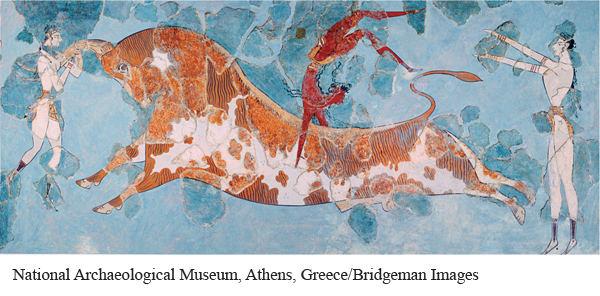A History of Western Society: Printed Page 63
A History of Western Society, Value Edition: Printed Page 57
A History of Western Society, Concise Edition: Printed Page 63
The Minoans
On the large island of Crete, Bronze Age farmers and fishermen began to trade their surpluses with their neighbors, and cities grew, housing artisans and merchants. Beginning about 2000 B.C.E. Cretans voyaged throughout the eastern Mediterranean and the Aegean, carrying the copper and tin needed for bronze and many other goods. Social hierarchies developed, and in many cities certain individuals came to hold power, although exactly how this happened is not clear. The Cretans began to use writing about 1900 B.C.E., in a form later scholars called Linear A. This has not been deciphered, but scholars know that the language of Crete was not related to Greek, so they do not consider the Cretans “Greek.”
What we can know about the culture of Crete depends on archaeological and artistic evidence, and of this there is a great deal. At about the same time that writing began, rulers in several cities of Crete began to build large structures with hundreds of interconnected rooms. The largest of these, at Knossos (NOH-
Few specifics are known about Minoan political life except that a king and a group of nobles stood at its head. Minoan life was long thought to have been relatively peaceful, but new excavations are revealing more and more walls around cities, which has called the peaceful nature of Minoan society into question, although there are no doubts that it was wealthy. In terms of their religious life, Minoans appear to have worshipped goddesses far more than gods. Whether this translated into more egalitarian gender roles for real people is unclear, but surviving Minoan art, including frescoes and figurines, shows women as well as men leading religious activities, watching entertainment, and engaging in athletic competitions, such as leaping over bulls.

Beginning about 1700 B.C.E. Minoan society was disrupted by a series of earthquakes and volcanic eruptions on nearby islands, some of which resulted in large tsunamis. The largest of these was a huge volcanic eruption that devastated the island of Thera to the north of Crete, burying the Minoan town there in lava and causing it to collapse into the sea. This eruption, one of the largest in recorded history, may have been the origin of the story of the mythical kingdom of Atlantis, a wealthy kingdom with beautiful buildings that had sunk under the ocean. The eruption on Thera was long seen as the most important cause of the collapse of Minoan civilization, but scholars using radiocarbon and other types of scientific dating have called this theory into question, as the eruption seems to have occurred somewhat earlier than 1600 B.C.E., and Minoan society did not collapse until more than two centuries later. In fact, new settlements and palaces were often built on Crete following the earthquakes and the eruption of Thera.